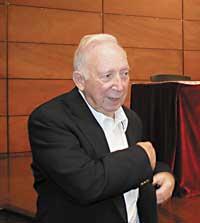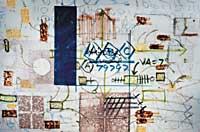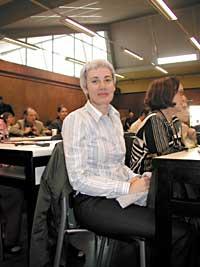Joseph Nova: "We couldn't even imagine that maps would have these"

New theories about the learning process emerged in the early 1960s. The previous theories were behavioral, but in front of them the constructivist theories that were explained were completely different. According to them, everyone builds their knowledge. I immediately understood that constructivist theories were appropriate and that it was necessary to put them into practice.
At that time I was a professor of biology and started teaching new theories. The results were surprising. There are many people who think it is very difficult to explain to eight-year-olds what energy is, but based on concepts they can understand build knowledge on that basis, and that form of learning is natural and effective. Precisely in this way we develop knowledge in our brain, and conceptual maps allow us to visualize this development. By hierarchically organizing concepts and explaining the relationships between them through propositions, the process that occurs in the brain is reflected on paper.
Thus we create conceptual maps. As I taught biology, at first I used them to explain biology topics, but then we started doing other disciplines: physics, chemistry... Then the others said to me: “Hey, Joe, it’s a good method to teach it.” This was in 1972-1973.
Conceptual maps therefore serve not only to teach biology, but also to teach other questions.No doubt. For example, at the same time we also made maps of poetry and sports. And we also started teaching people how to make maps. Then we did it by hand, in paper and pencil, but soon the first computers appeared and we realized that the computer was the ideal tool to make maps. Years 80.
In 1987 we took another step. I took a gap year and went to Pensacola. There, a psychologist friend from the University of West Florida introduced me to Ken Ford. Ken Ford had just finished his thesis on artificial intelligence and taught him the work on concept maps. Artificial intelligence is intended to simulate the functioning of the human brain. Therefore, the goal is to know how the brain builds knowledge. And in collaboration we began to develop software to develop concept maps at the institute. Specifically, we started in 1989 and currently have the Cmap Tools software to make maps.

The first application was the development of technology for the detection of heart disease. To carry out the project we built concept maps with doctors and radiologists. In the maps we collected the process and conclusions of the research itself and realized that there were dark points. Surprisingly, clarification of these dark points of maps allowed researchers to improve technology.
Concept maps have many other applications besides teaching...Yes, that is. For example, we have worked with NASA, the U.S. Army, etc. In 1993 we started with the company Procter Gamble and those of the company soon saw that it is a very effective tool to carry out projects. It is now used in any type of company or entity. It is useful for all, since it is based on basic concepts on which everything is built according to the needs and characteristics of each one. Valid for all areas.
And do they serve any culture of the world? Are conceptual maps universal?Yes, they are universal, they are used worldwide. In fact, concept maps are based on brain biology, which does not vary from place to place.
On the other hand, it seems worthy of mention that conceptual maps also help in the psychological aspect. Thanks to concept maps, in addition to learning more easily than traditional methods, students have more confidence in themselves. Somehow, the learning process is more natural and intuitive, but the main feature is that everyone builds knowledge. Consequently, student self-esteem is better.

By the way, concept maps also help solve certain behavioral problems. For example, when working with women with anorexia and bulimia, we have seen that many of them have a lot of uncertainty. Because the learning process has a lot to do with it. The fact that they often do not understand the subject by learning the subjects of memory leads to insecurity. By learning with concept maps, they build knowledge, which helps them regain confidence. Explaining their problem through concept maps also helps them a lot.
However, it will not be easy to explain the problems of one's life in concept maps.You have to learn how to make maps, but the effort is worth it. For example, we did an experiment with nine people addicted to drugs. After they reflected their behavior and their problem on the maps, they realized the things that had to be changed. In two years, the nine managed to quit the drug.
To some extent I also owe conceptual maps to be so good (laughs) with the age I have. Actually, when we started working with the children in teaching, we could not imagine that they were going to have these applications: medical, clinical, psychological applications...
As heard in the congress, concept maps also allow you not to lose knowledge. Isn't it Alberto?That is. In the knowledge society, the most important asset of companies is the knowledge of experts, whose disappearance risks losing it. Books, reports, etc. are saved. but not decisions, processes... For example, the Apollo containers sent to the Moon are possible again, as NASA has saved planes, but the decisions that made it possible for man to reach the Moon have been lost forever.
Companies are realizing that it is very expensive to reproduce all that knowledge, and the question is how to catch and retain expert knowledge. This can be done through concept maps. Lately we are working with US nuclear companies. because new facilities are no longer made and young people do not study nuclear engineering. Consequently, as engineers retire, this knowledge is being lost.

The Queen of Thailand is also very concerned that the new generations are not interested in maintaining their traditional customs, and that crafts, gastronomy and rituals may be in danger of extinction. Now they are saving it through conceptual maps.
Joe tells us that concept maps can be used in all spheres, in all ages and in all cultures. Do they have limits?Yes. Maps do not solve problems themselves. If used in teaching, the teacher should know how to make maps, and students should know how to use them. It is useless for a teacher to give students a concept map on Friday to bring them learning about Monday.
Concept maps are a tool. If used well it is a very powerful tool, but if misused it is totally inadequate and wrong. According to experts, the realization of concept maps is what is most learned. It is also a unique tool to foster collaboration.
Alberto, you have been in Pamplona for a year. What have you been in?I have been invited by the Public University of Navarra and the aim was to organize this congress. In addition, I have been involved with the Ikastolas Federation, for their interest.
The truth is that private education more easily supports working with concept maps. The more organized and structured an organization is, the more difficult any change is and I think that is why it is spreading more in private education. The same happens in underdeveloped countries. It seems that the poorer a school is, the more it takes advantage when it finds a good tool. This explains that in South America the teaching through concept maps is so well received.
The use of concept maps is widespread especially in Italy and Brazil, but taking into account the interest that exists here, I think that also in Euskal Herria can have a great diffusion.
Building concept maps in Basque
Arantza Gurutze is a professor at the ikastola San Fermín in Pamplona. A few years ago, concerned about the students' attitude to studies, he questioned the suitability of the learning process. Using concept maps, he believed that the students' motivation and level of knowledge would be better, and to prove it he did his thesis.

He then realized that the criteria in Spanish and English for developing concept maps are not valid in the case of Basque. In fact, the words in Basque are declined, so in the concepts you can not put the words without suffixes, but the phrases on the map cannot be read completely. How to put suffixes so that sentences are formed and at the same time the map is clean and easy to understand? There is the key.
According to Arantza, there is no single solution. One way can be to place the suffixes in the joints, expressed by dashes. Another is the decline of concepts, but therefore you cannot start any phrase from a declined concept. Depending on the use, sometimes a complete phrase can be put as a concept or, in others, it may not matter that the words are not declined, since the phrases can be easily completed with memory suffixes.
The debate is open and will undoubtedly overcome obstacles as the road progresses.
Buletina
Bidali zure helbide elektronikoa eta jaso asteroko buletina zure sarrera-ontzian












